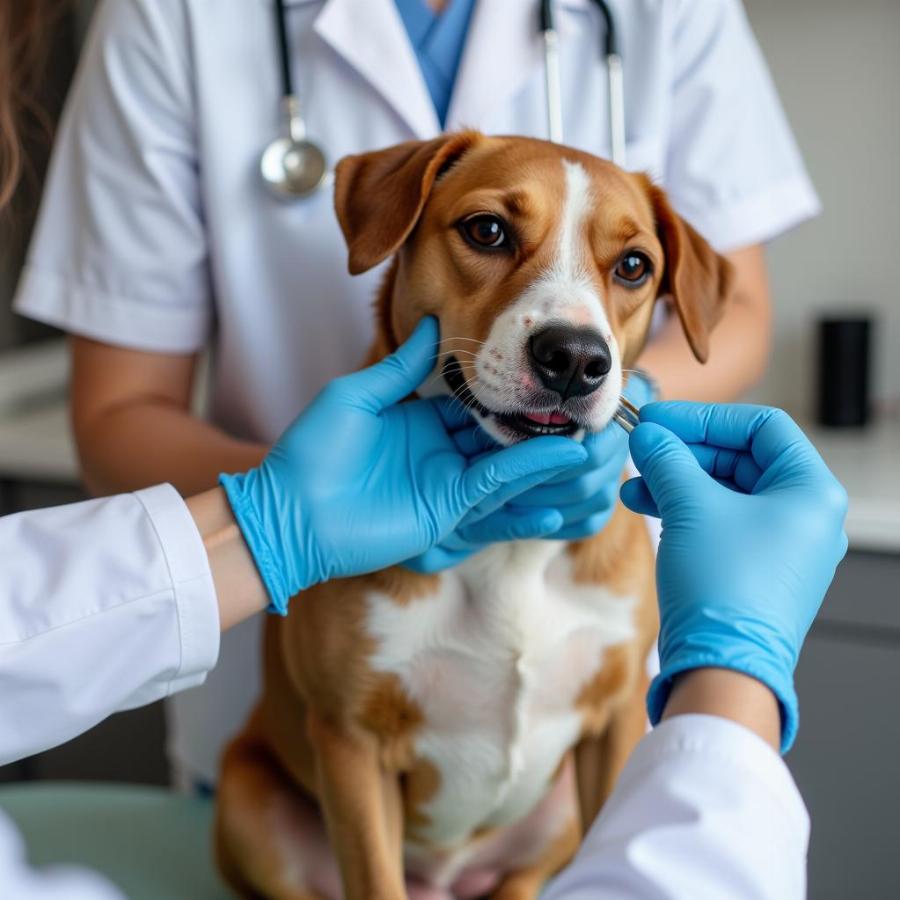Gum growth in dogs, also known as gingival hyperplasia, is a condition where the gum tissue grows excessively, creating folds and covering more of the teeth than normal. While it might seem like a minor issue, gum overgrowth can impact your dog’s oral health and overall well-being. This article will explore the causes, symptoms, and treatment options for gum growth in dogs, empowering you to provide the best possible care for your furry friend.
Causes of Gum Growth in Dogs
Several factors can contribute to excessive gum growth in dogs. Understanding these causes can help you take preventative measures and seek timely veterinary care. Here are some common culprits:
- Genetics: Some breeds, such as Boxers, Bulldogs, and Great Danes, are genetically predisposed to gum overgrowth.
- Poor Oral Hygiene: Plaque and tartar buildup irritate the gums, leading to inflammation and potential overgrowth.
- Medications: Certain medications, like anticonvulsants and immunosuppressants, can have gum overgrowth as a side effect.
- Systemic Diseases: In some cases, underlying health conditions like hormonal imbalances or certain types of cancer can trigger gum overgrowth.
Recognizing the Signs of Gum Growth
Early detection is crucial for effective management of gum overgrowth. Keep a close eye on your dog’s oral health and watch for these telltale signs:
- Visible Swelling: The gums appear enlarged and puffy, extending further down the teeth than usual.
- Changes in Gum Color: Instead of a healthy pink, the gums might look red, inflamed, or even pale.
- Bleeding Gums: You might notice blood on your dog’s chew toys, in their water bowl, or when you brush their teeth.
- Bad Breath: Persistent bad breath, even after brushing, can be a sign of gum disease and potential overgrowth.
- Difficulty Eating: Overgrown gums can make it painful for dogs to chew, leading to decreased appetite or difficulty picking up food.
Diagnosis and Treatment Options
If you suspect your dog might have gum overgrowth, it’s essential to consult a veterinarian for a proper diagnosis and treatment plan. The veterinarian will examine your dog’s mouth, review their medical history, and might recommend dental X-rays to assess the severity of the condition.
Treatment for gum growth in dogs varies depending on the underlying cause and the extent of the overgrowth. Here are some common treatment approaches:
- Professional Dental Cleaning: A thorough cleaning under anesthesia removes plaque and tartar buildup, addressing the primary irritant that contributes to gum inflammation and overgrowth.
- Gingivectomy: In cases of severe overgrowth, a surgical procedure called a gingivectomy might be necessary. This procedure involves removing the excess gum tissue, reshaping the gums, and promoting healthy tissue regeneration.
- Medications: If an underlying medical condition is causing the gum overgrowth, treating the primary condition often helps manage the gum issue as well.
 Veterinarian Checking Dog's Gums
Veterinarian Checking Dog's Gums
Preventing Gum Overgrowth in Dogs
While not all causes of gum overgrowth are preventable, you can significantly reduce the risk by implementing these proactive measures:
- Regular Brushing: Just like humans, dogs benefit from daily brushing. Use a dog-specific toothbrush and toothpaste to gently clean their teeth and massage their gums.
- Dental Chews and Toys: Provide your dog with dental chews and toys that help scrape away plaque and tartar as they chew.
- Regular Veterinary Dental Checkups: Schedule professional dental cleanings and checkups with your veterinarian at least once a year, or more frequently if your dog is prone to dental issues.
- Balanced Diet: Feed your dog a balanced and nutritious diet, avoiding sugary treats and foods that can contribute to plaque buildup.
When to Seek Veterinary Attention
Don’t ignore the signs of potential gum issues in your dog. Early intervention is key to preventing more serious complications. Contact your veterinarian immediately if you notice:
- Excessive drooling
- Difficulty chewing or swallowing
- Loss of appetite and weight loss
- Foul odor coming from the mouth
- Blood in your dog’s saliva or water bowl
FAQs about Gum Growth in Dogs
Q: Is gum overgrowth painful for dogs?
A: Yes, gum overgrowth can be painful for dogs, especially as it progresses and starts to affect their ability to eat and maintain proper oral hygiene.
Q: Can gum overgrowth lead to other health problems?
A: Yes, untreated gum overgrowth can lead to periodontal disease, tooth loss, and even increase the risk of infections spreading to other parts of the body.
Q: Can I treat my dog’s gum overgrowth at home?
A: While maintaining good oral hygiene at home is crucial, it’s not a substitute for professional veterinary care.
Seeking Expert Advice for Your Dog’s Oral Health
Maintaining good oral hygiene is essential for your dog’s overall health and happiness. If you have any concerns about your dog’s gum health, don’t hesitate to reach out to a veterinarian for personalized advice and treatment options.
For tailored guidance and support regarding your dog’s oral health, feel free to contact the experts at Beaut Dogs** via email at [email protected]. We are here to provide you with accurate information and address any concerns you may have.
Beaut Dogs is your trusted source for all things dog-related. Our mission is to provide dog owners with comprehensive and reliable information to help them provide the best possible care for their furry companions. Visit our website at https://beautdogs.com for more valuable insights, tips, and resources to ensure a happy and healthy life for your beloved dog.